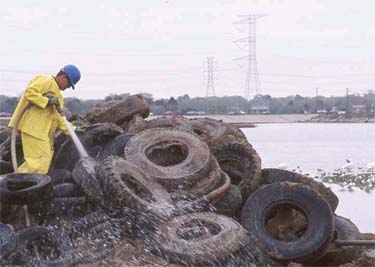 |


|
|
Most U.S. Coastal Waters Polluted
|
|
By Cat Lazaroff Environmental News Service WASHINGTON, DC (ENS) - Almost half the nation's coastal waters are so polluted that their usefulness to humans and their ability to support aquatic life are impaired, finds a new report by a quartet of federal agencies. The study, the first environmental report card on the condition of the nation's coastal waters, rates the quality of these resources as fair to poor.

The findings, based on data collected between 1990 and 1997, provide a baseline reading on conditions for select coastal regions, primarily estuaries - the zones where salt and fresh water mix. The U.S. Environmental Protection Agency (EPA), which sponsored the report along with other federal agencies, says the report will help the administration monitor efforts to improve coastal water quality. The report was developed in collaboration with the National Oceanic and Atmospheric Administration, U.S. Geological Survey, and the U.S. Fish and Wildlife Service. It reveals that only about 56 percent of the estuary area in the continental United States is in good condition for supporting aquatic life, including animal and plant communities, and human uses such as drinking water, agriculture, swimming and boating. Aquatic life in about 34 percent of the estuary area is already impaired, and 33 percent of the area is too polluted for many human uses. "It took decades for the coasts to get this way and though progress has been made, there is much work still to do," said Robert Wayland, director of the EPA's Office of Wetlands Oceans & Watersheds. "Virtually the whole landscape of the United States drains into the coasts," continued Wayland. "This report emphasizes the ecological and economical importance of these areas. We need to encourage efforts to protect the coasts by emphasizing watershed protection, restoring habitats, and reducing non-point source and point source pollution." The study covers more than 70 percent of the estuarine area of the lower 48 states, including all areas except New England and the west coast. Using data from federal coastal monitoring programs and state assessments, the current study looked at seven indicators of ecological condition: water clarity; dissolved oxygen; loss of coastal wetlands; accumulation of contaminants in fish tissue; contamination in underwater sediments; the condition of benthic or sediment living creatures; and the amount of nutrients in the water. Based on these indicators, 56 percent of the estuaries the researchers examined were in good condition, while 44 percent were characterized by impaired human use or impaired ability to support aquatic life. The nation's coastal areas were rated as poor if measurements of the seven indicators showed that greater than 20 percent of the estuarine area in that region was degraded. The biggest problems facing the nation's coastal waters, according to the report, are wetland loss, loss of benthic diversity, and excess nutrients in the water, a condition known as eutrophication. During the 200 year period from 1780 to 1980, almost 50 percent of the historic wetlands in the lower 48 United States were lost, the report notes. Despite efforts to protect remaining wetlands and restore some lost wetlands areas, the nation is still losing hundreds of acres of wetlands every year. Contaminated sediments, which plague all the Great Lakes areas and many other estuaries, are contributing to the poor health of most benthic ecosystems, the researchers found. For example, 11 to 30 percent of estuarine sediments in the U.S. show concentrations of PCBs, pesticides and heavy metals that are above the safety levels set by the government.
 Almost 50 percent of the nation's historic coastal wetlands had been lost by 1980.
Estuaries in the northeastern states showed the most sediment contamination. Across the nation, 40 percent of estuarine sediments are polluted by heavy metals, 45 percent are contaminated with PCBs, and 75 percent contain pesticides.
Almost 50 percent of the nation's historic coastal wetlands had been lost by 1980.
Estuaries in the northeastern states showed the most sediment contamination. Across the nation, 40 percent of estuarine sediments are polluted by heavy metals, 45 percent are contaminated with PCBs, and 75 percent contain pesticides.
Contamination of fish tissues occurred across the nation, although concentrations of contaminants were low in most areas, with the exceptions of the northeastern estuaries, the Gulf of Mexico and the Great Lakes. Almost every estuarine area studied contained too many nutrients, including nitrogen from fertilizers, which drain into coastal areas from farmlands and suburbs. All the coastal areas were rated in poor condition based on their eutrophication, with the exception of the southeast, which is in fair condition, and Alaska and Hawaii, which were not evaluated. The researchers caution that using indicators to compare estuarine conditions throughout the nation can be misleading, because the natural state of estuaries varies. For example, estuaries in the southeast tend to have poor water clarity due to the natural action's of the region's rivers and tides. "So the 'fair' water clarity rating in southeastern estuaries does not necessarily mean that water quality is poor or degraded," the researchers note. Comprehensive coastal surveys are now being conducted in all coastal states, including Alaska, Hawaii and Puerto Rico, and the results of these surveys will be available in 2004. Surveys of the nation's offshore waters, ranging from zero to 12 miles from shore, are planned for later this year, and the results are expected to be available in 2005. The EPA says the Bush Administration is taking several steps to address problems with coastal waters, including proposing $21 million in new funding for watershed protection. The EPA has given grants to states to address bacterial contamination at beaches. The agency is also working with states, tribes, and other federal agencies on an action plan to address the dead zone in the Gulf of Mexico, a large oxygen starved area where no fish or other marine creatures survive. The dead zone, caused by massive algae blooms and die offs fed by the nutrient rich runoff of the Mississippi River, threatens one of the nation's most productive and valuable fishing grounds. Wayland said the information in the current report will allow the EPA to monitor the progress of ongoing coastal water quality protection programs, analyze trends, and identify gaps in data about coastal areas. The EPA plans to do future studies to determine where water quality improvements are already occurring in coastal areas, and which areas need to be the focus of further work. |

© 1997-2002 BEI